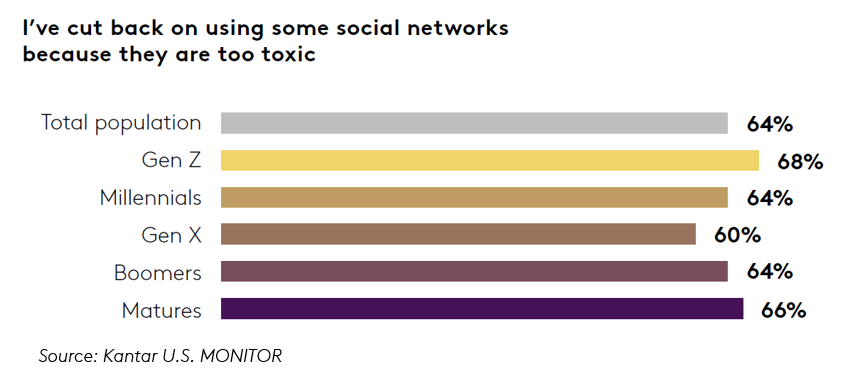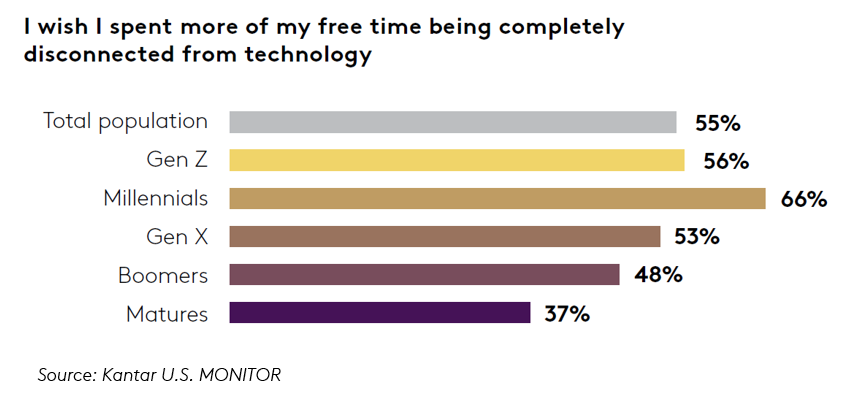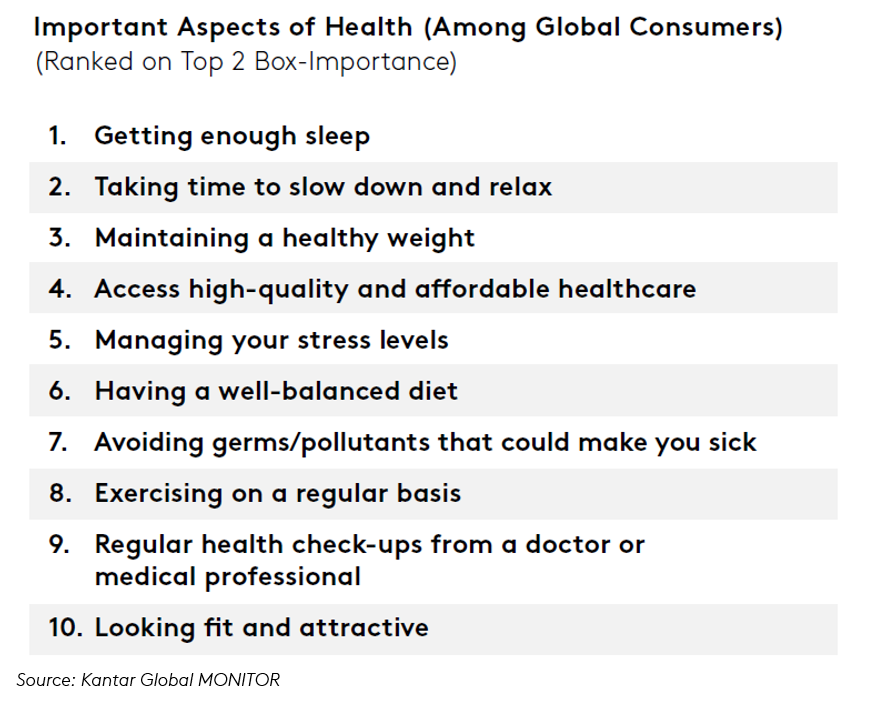Tech was a lifeline for many during the COVID-19 pandemic. Our digital devices, media, apps – and lifestyles – kept people connected, entertained, and employed. But as we emerge into the post-pandemic era, we are still glued to screens as never before: up to 16 hours a day when accounting for overlapping screen time in an age of multitasking, according to the Wall Street Journal.
This isn’t an invisible shift. A recent Kantar study showed that consumers have taken notice of tech’s dominant role in their lives – and, furthermore, have begun to worry about its effect on their health.
Call it ‘digital duress’: a rise in anxiety, depression, inactivity, sleeplessness, and even PTSD, brought about by spending more of our lives online. These are all old symptoms that have acquired new, screen-mediated triggers – but there are also new hazards wreaking havoc on people’s wellbeing as well: these include Zoom dysmorphia, eco-anxiety, doom scrolling, compulsive binge watching, and toxic remote workplace environments.

For tech and healthcare brands, these many shifts present both opportunities and challenges. On the one hand, as health brands become more digitally native and embrace breakthrough tech innovations, they will become newly capable of helping consumers improve their health across many holistic dimensions – including ‘digital duress’. On the other hand, consumers will need to grant both technology and healthcare brands the right to play this kind of enhanced symbiotic role – and in that respect, healthcare brands’ digitalization drives may actually increase the risk of mistrust (at a time when consumers are already dissatisfied with rising costs and lack of empathy from traditional healthcare providers).
Consumers are already tired of endless notifications pings, invasive app tracking, and flashy enticements for one-click ordering – in other words, tired of the common trappings of contemporary digital brands. In this context, newly tech-savvy healthcare brands will have to prove that they are ‘sheep in wolves’ clothing’: prove, with authenticity, that their technological innovations will, ultimately, further the cause of helping people establish a new and healthier lifestyle balance for the digital age.

How data-fueled, tech-enabled health products and solutions can help
Even as they seek to rebalance their relationships with technology, consumers continue to adopt health monitoring technology, and businesses are developing offerings with increasingly sophisticated ways to use the data from these new technologies. This data is opening new doors to personalized healthcare – with the potential for care to be more effective and efficient for both consumers and businesses.
Consider this list of the top 10 most important aspects of health, as ranked by consumers in a recent Kantar Global MONITOR study. For many, if not all, of these concerns, there are now widely available or emerging technology tools to help consumers make measurable progress toward living healthier lives.

Going forward, data-driven healthcare will become even more effective, thanks to a new generation of digital peripherals. Heart rate, ECGs, and blood oxygen saturation levels are now standard on many smartwatches, and in the US, some have government approval for detecting abnormalities such as atrial fibrillation. In the near future, smartwatches may also be able to perform continuous glucose monitoring (CGM) for diabetics without the need for needles – a functionality that Apple is already in advanced stages of bringing to market. Already, ‘smart patches’ that affix directly to patients’ skin (to act as biosensors, and sometimes even deliver medications) are revolutionizing the CGM market at a time when diabetic populations are rising worldwide.
Moving from the physical world, the metaverse (and its associated peripherals) will further drive the digitization of health services and products; many hospitals are starting to experiment with using virtual reality to block pain signals from reaching the brain, while Meta is helping to build tools that allow surgeons to practice their skills virtually.
Smart data can also be harnessed to improve mental health outcomes – and it can even be embedded directly within workplace software, the better to address office-related stresses such as ‘zoom fatigue’ and ‘always-on’ hybrid work burnout. Microsoft Viva Insights, for instance, uses data to help users better divide their focus time into bursts of productivity. It can also tell managers how much they’ve caused team members to work outside working hours – and prompt employees to set aside dedicated focus or break time.
’The future of health is consumer-driven’, said Karen DeSalvo, chief health officer at Google at a recent company event in Manhattan. ’People will expect a mobile-first experience with more personalized insights, services, and care. That means enterprises, including Google, will need to evolve to meet consumers where they are’.
![]()
Reimagining healthcare ecosystem brands
Rife with opportunity, the ecosystem of brands at the intersection of technology and healthcare continues to grow. Nuance, a Microsoft company, is at the forefront of innovating conversational and ambient AI in healthcare. Their latest solutions – DAX Express – use a unique combination of conversational, ambient, and generative AI to draft clinical notes in seconds, for immediate clinical review after each in-person or telehealth patient visit.
Pharmaceutical retail brands, a critical part of the healthcare ecosystem, also need to consider their right to play in the digital healthcare space. The future of pharmacy is ‘healthcare offline, value creation online’ – as digital health will continue to accelerate service investments in-store, and increase shopper expectations online. In the US, CVS has accelerated investment in its digital health capabilities to build a comprehensive healthcare ecosystem, HealthHUB, that contains a variety of interactive digital health apps. Walgreens is also rapidly developing a digital healthcare network.
Meanwhile, digital health companies like OptimizeRx and Outcome Health leverage data connectivity to provide point-in-time, end-to- end personalized healthcare and membership-based digital healthcare services. And players like MDVIP and Sollis Health are enabling proactive personalized care.
And then there’s Amazon. The retail giant recently announced it was adding RxPass to its pharmacy footprint, giving Amazon Prime Members access to many generic drugs with free at-home delivery for a flat fee. While there are limitations that need to be worked out, Amazon is also working to implement HIPAAcompliant methods for Alexa to transmit and receive protected health information, so that Alexa can offer general health and wellness skills from developers.
In the near future, then, pharmacy brands will be able integrate data from digital healthcare platforms, consumers, and vendors – to provide personalized offers, as well as create fixed-revenue streams via fee-based digital healthcare program tiers.
Putting it together
So, in conclusion, brands operating in the intersection of the technology and healthcare ecosystems need to focus on the following six implications:
- Enable instant rest and relaxation: People want to rest, recharge, and relax for mental and physical health, but find it difficult to set aside the time. Businesses will create an increasing number of digital and tech-enabled offerings that offer rapid relaxation, rest, and immersive experiences that promise quick rewards.
- Deliver exclusive efficacy: Technological advances, combined with economies of scale, will make personalized healthcare delivered through devices and digital platforms widely accessible (and affordable). Consumers will begin to believe that if a product or service is not tailor-made precisely for them, then it will not be efficacious for them personally.
- Leverage influencers: Many consumers – particularly younger ones that do not distinguish between their physical and virtual worlds – are interested in discovering products, services, and practices digitally through influencers or in the metaverse. Think of influencers as a means to amplify and endorse your business’ health and wellbeing products and services – and also as a method of ‘crossing over’ to other non-health categories via trusted, personal endorsements.
- Offer meaningful solutions: As consumers look to find high-quality technologically advanced healthcare solutions with budget prices, give them a reason to buy your brand in a physical or virtual pharmacy environment of their choice. Ensure you maintain their trust and amplify brand equities; doing so gives consumers, who may be financially constrained, good reason to purchase a branded choice like yours over economical, commodified alternatives.
- Encourage long-term compliance: Consumers may desire long-term results in areas like anti-ageing, joint preservation, healthy weight loss, and disease prevention. But they will continue to find wellness-related actions difficult to maintain over the long run. When creating tech-enabled products and online services, build in elements to make it encouraging and easier to continue efforts: visible results, quantitative measurement goals, social experiences, and so on.
- Utilize social determinants of health models: As consumer health data sources grow more comprehensive and privacy becomes more secure, big data and artificial intelligence will allow for better accounting around social determinants of health. These include education, environmental factors, family dynamics, and cultural nuance – all of which can be used to predict the health outcomes of individuals more accurately.
Technology is changing everything. For manufacturers of TVs, smartphones, laptops, tablets, wearables, and network operators, Kantar’s global technology insight experts show you how to shape the brands of tomorrow. Read our industry thought leadership here.
The entire Kantar BrandZ Most Valuable Global Brands 2023 report, including detailed category and brand analyses, is available now from www.kantar.com/campaigns/brandz/global

